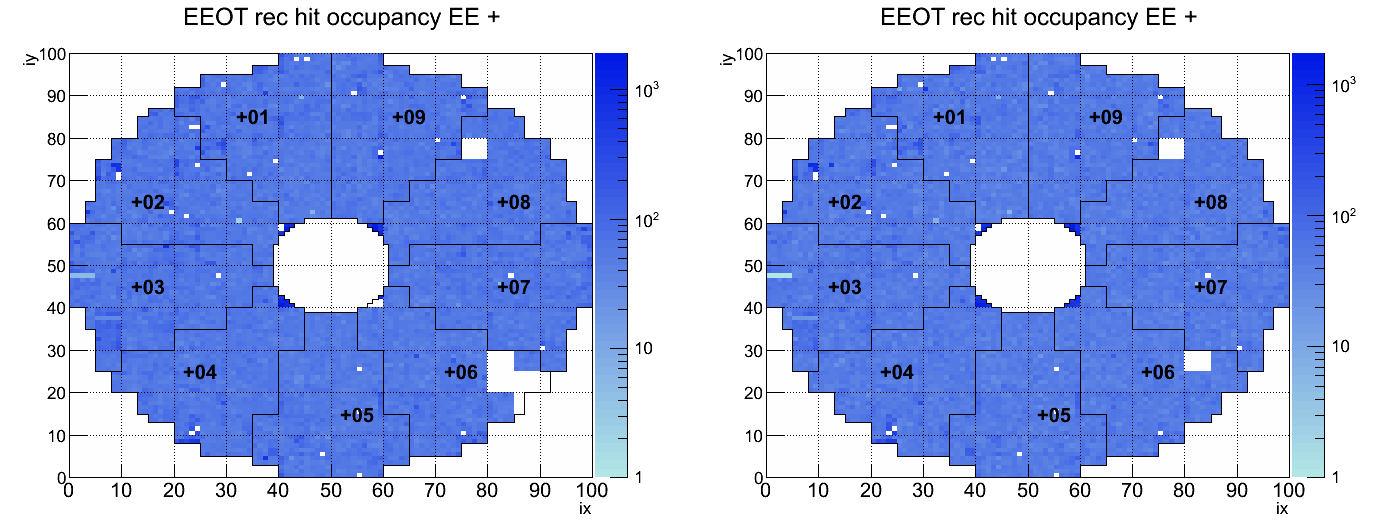
The CMS Electromagnetic Calorimeter (ECAL) is responsible for measuring electrons and photons produced in collisions inside the detector. It comprises of 75,848 lead-tungstate crystals, each with its own photodetector and electronics to form readout channels. One region, consisting of 75 channels in the positive ECAL endcap, had been inoperable since 2009. It was not possible to supply low-voltage power to the channels, resulting in a completely dead region of the detector.
A particle impinging on the problematic region will record no trace in the ECAL. This will lead to apparent missing energy in the reconstructed collision event. This impacts the sensitivity of a number of exotic physics searches in CMS, many of which look for events with missing energy in the final state.
The performance of the 75 channels gradually deteriorated throughout 2009. After the problem surfaced, it was only possible to power 50 of the 75 channels, then only 25, then none at all. It was believed that the problem was due to a loose low-voltage connection inside the detector. It was therefore necessary to wait until the 2013-’14 long shutdown, when CMS would be opened, before the problem could be further investigated.
A plan was developed to investigate the problematic region in situ without the need to dismount the endcap. Fortunately, the region was close to the edge of the detector and it was therefore possible to peer inside the detector via a small pre-existing access hole, (using a manually-guided endoscopic camera) and examine the problematic region and its surroundings. Great care was needed in this operation, since the region contains not only the low-voltage cables that were suspected to be causing the problem, but also delicate optical fibres that provide the detector readout and trigger signals.
To assist in this operation the team built an accurate 1:1 scale model that was originally constructed at the Rutherford Appleton Laboratory in the UK and now sits in building 892 at the Prevessin site at CERN. The model allowed the project members to practice operating the endoscope and to try out various ideas to carry out the repair, in order to determine (and practice) the best approach before performing it on the real thing.
The low-voltage cables inside the detector that supply power to the 75 channels needed to be unplugged from the inside and brought to the outside (through the access hole) to examine them and carry out the necessary repairs. The main difficulty here was to cut a cable tie securing the heavy copper low-voltage cables in place that was installed during the construction of the endcaps. This was achieved by means of a small-diameter cylindrical cartridge heater that was carefully introduced inside the detector. A controlled burst of heat was then applied to cut the cable tie.
Once the low-voltage cables were pulled out from the detector, the problem became clear. The power and return lines inside the detector had faulty contacts, explaining why we were unable to power the 75 channels. The cables were subsequently connected and secured to the outside of the detector. The newly-repaired region was tested during the November 2013 global run of the CMS detector and operated perfectly, a source of great satisfaction to the whole ECAL team. The region will be checked again in late 2014, with the CMS magnet at 3.8 teslas and should be ready to be used for CMS physics data in Run II.
We gratefully acknowledge the contributions of a team of mechanical engineers from RAL, working in collaboration with ECAL project scientists and engineers from RAL, CERN and ETH Zurich, who were involved in the successful execution of this project.
- Log in to post comments

